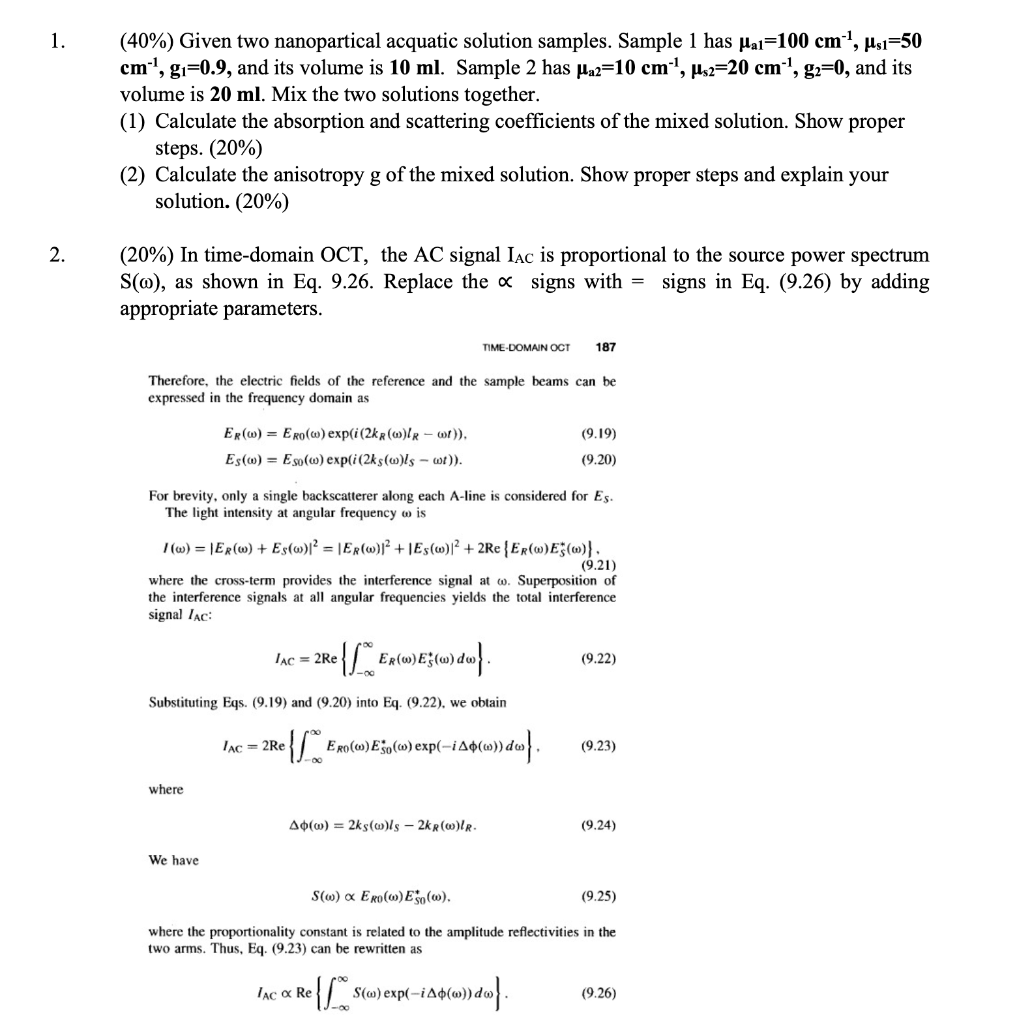
1. (40%) Given two nanopartical acquatic solution samples. Sample 1 has Hai=100 cm', us1=50 cm', g1=0.9, and its volume is 10 ml. Sample 2 has Maz=10 cm", Ms2=20 cm~', g2=0, and its volume is 20 ml. Mix the two solutions together. (1) Calculate the absorption and scattering coefficients of the mixed solution. Show proper steps. (20%) (2) Calculate the anisotropy g of the mixed solution. Show proper steps and explain your solution. (20%) 2. (20%) In time-domain OCT, the AC signal lac is proportional to the source power spectrum S(@), as shown in Eq. 9.26. Replace the signs with = signs in Eq. (9.26) by adding appropriate parameters. TIME-DOMAIN OCT 187 Therefore, the electric fields of the reference and the sample beams can be expressed in the frequency domain as (9.19) Er(W) = Ero(w) exp(i (2kr( WR-6)). Es(w) = Eso(w) exp(i (2ks(w)ls - wt)). (9.20) For brevity, only a single backscatterer along each A-line is considered for Es. The light intensity at angular frequency w is (w) = \Er(w) + Es(w)? = Er(w)| + |Es(w)2 + 2Re {Er(w)E$(w)}, (9.21) where the cross-term provides the interference signal at w. Superposition of the interference signals at all angular frequencies yields the total interference signal lac LAC = 2Re e{LEr(w) Ez(w) dow). (9.22) -00 Substituting Eqs. (9.19) and (9.20) into Eq. (9.22), we obtain IAC = 2Re che E xo(m) Eso(w) exp(-i A6(w)dw} ( (9.23) where A$(w) = 2kswls - 2kwlr. (9.24) We have S(w) Ero(o) E$(w). (9.25) where the proportionality constant is related to the amplitude reflectivities in the two arms. Thus, Eq. (9.23) can be rewritten as Tac a Re VI S(w) exp(-ia (-ia(w)ds). (9.26) 1. (40%) Given two nanopartical acquatic solution samples. Sample 1 has Hai=100 cm', us1=50 cm', g1=0.9, and its volume is 10 ml. Sample 2 has Maz=10 cm", Ms2=20 cm~', g2=0, and its volume is 20 ml. Mix the two solutions together. (1) Calculate the absorption and scattering coefficients of the mixed solution. Show proper steps. (20%) (2) Calculate the anisotropy g of the mixed solution. Show proper steps and explain your solution. (20%) 2. (20%) In time-domain OCT, the AC signal lac is proportional to the source power spectrum S(@), as shown in Eq. 9.26. Replace the signs with = signs in Eq. (9.26) by adding appropriate parameters. TIME-DOMAIN OCT 187 Therefore, the electric fields of the reference and the sample beams can be expressed in the frequency domain as (9.19) Er(W) = Ero(w) exp(i (2kr( WR-6)). Es(w) = Eso(w) exp(i (2ks(w)ls - wt)). (9.20) For brevity, only a single backscatterer along each A-line is considered for Es. The light intensity at angular frequency w is (w) = \Er(w) + Es(w)? = Er(w)| + |Es(w)2 + 2Re {Er(w)E$(w)}, (9.21) where the cross-term provides the interference signal at w. Superposition of the interference signals at all angular frequencies yields the total interference signal lac LAC = 2Re e{LEr(w) Ez(w) dow). (9.22) -00 Substituting Eqs. (9.19) and (9.20) into Eq. (9.22), we obtain IAC = 2Re che E xo(m) Eso(w) exp(-i A6(w)dw} ( (9.23) where A$(w) = 2kswls - 2kwlr. (9.24) We have S(w) Ero(o) E$(w). (9.25) where the proportionality constant is related to the amplitude reflectivities in the two arms. Thus, Eq. (9.23) can be rewritten as Tac a Re VI S(w) exp(-ia (-ia(w)ds). (9.26)







